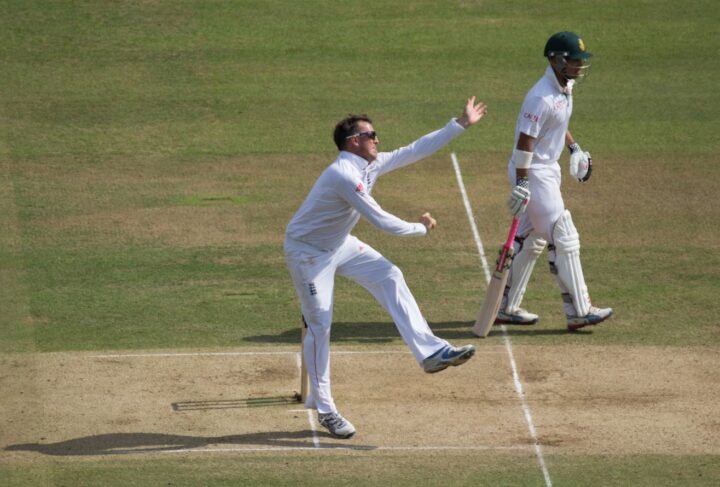Today is a quiet day. There’s not much to talk about other than Steve Smith’s T20 heroics against Pakistan down under. Therefore, in a desperate attempt to avoid talking about Steve Smith’s T20 heroics down under, I’ve decided to trial something new. It’s the first in what I hope will become an ongoing series called Myth Busters.
In each instalment we’ll analyse a commonly held cricketing conviction and then systematically dismantle it. Think of it as a TFT truth filter or anti-BS aid. After all, why should intolerant sods like us tolerate some of the more absurd opinions floating around the ether?
So let’s get started with today’s myth …
The best player should bat at 3
This notion that the best player should bat at 3 is as ubiquitous as flies on a cow pat. I’ve heard Ian Botham say it; I’ve heard Bob Willis say it; and I’ve heard hundreds of supporters across the land say it.
But just because we hear this a lot (especially in relation to Joe Root) doesn’t make it true. After all, I’ve heard plenty of people argue that Elvis is alive and well and working in Aldi.
So where did this boneheaded myth come from? I actually have no idea. Perhaps it emerged years ago because Don Bradman batted at 3 and then arguably the greatest player of the modern era, a certain IVA Richards, also batted at 3. But what about all the other greats?
Steve Smith bats at 4 in Australia’s Test team. Virat Kohli also bats at 4. Brian Lara spent more time at 4 than 3. What’s more, Sachin Tendulkar, who is probably the most revered cricketer of the last twenty years, also mostly batted at 4.
What’s interesting about Sachin is that he also occasionally batted at 5 (in 26 tests) and at 6 (14 Tests), and he even opened the batting once. In fact, he batted at every single spot in India’s top seven except for – you guessed it – number 3! How can that be if the myth we’re busting is correct?
The truth, of course, is that batsmen should simply bat in the position that suits them best. And that isn’t always No.3. What if your best player is a traditional opener or a swashbuckling counter-attacker? It’s daft to suggest that the best player should bat 3 even if their technique and temperament is better suited to another position.
Perhaps the batsman that illustrates my point best is Steve Waugh who batted at 5 in 102 of his 168 Tests. In my opinion Waugh (alongside Alan Border) is the best Australian batsman I’ve seen. And although the teams he played in were also full of fantastic players like Mark Waugh, Dean Jones, Matt Hayden, Adam Gilchrist, and David Boon, the captain was always the wicket I wanted most.
Waugh would not have made a particularly good 3. His somewhat rugged technique and sheer bloodymindedness were best suited to the middle-order where he could either rescue an innings or press home an advantage. Waugh knew it and the Australian selectors knew it too.
Even if one could, hypothetically, disregard technique and form a coherent argument that the best player should indeed bat 3 – even though all the players I’ve listed above plus Javed Miandad and Martin Crowe would blatantly disagree – this argument would still be fatally undermined by another factor: human psychology.
Cricket is a mental game and batsmen are usually a superstitious, idiosyncratic, and anxious lot. Just look at all of Steve Smith’s mannerisms, or the way Neil McKenzie used to strap one of his spare bats to the dressing room roof before he walked out to the middle. Cricketers need to feel comfortable to perform at their best; therefore many of them have a favourite place to bat even if (as is sometimes the case) there’s no tangible reason why they’ll be better off in this spot.
Joe Root is the classic exemplar of this. Although I personally think he’s better suited to No.4 (or even number 5) because he plays with a somewhat open face and defends to point / gully too much for my liking, most observers disagree. They see no reason why the England captain couldn’t and shouldn’t bat at 3.
I can understand their logic here: Root used to be an opener, once scored a century against Australia at Lord’s as an opener, and they think it should be the captain’s responsibility to fill what has often been a problematic position rather than ask a relative newbie like Joe Denly or Jason Roy to do it.
The problem, however, is that Root prefers to bat at 4 and he’s always been a lot more productive in that role. He averages 48 at No.4 and just 38 (which is a poor return for a player of his class) at No.3. He also averages 71 at No.5 but I won’t get into that now.
We can have have drunken arguments in the pub until last orders over whether Root’s problems at 3 are either technical or mental. But at the end of the day it doesn’t matter. The bottom line is that he’s diminished at 3 and simply doesn’t score the runs he should do there.
So why sacrifice the productivity of the team’s best player for the sake of gut feeling or fallacy that the best player should bat 3 and impose himself on the opposition? It makes no sense.
I’ll leave you with the thoughts of Australian great Ian Chappell who should know a thing or two about batting at first drop – after all, he batted at 3 in 54 Test matches and scored thirteen tons at an average of 51 in this position:
There is a lot of codswallop spoken and written about the No. 3 spot. For instance, some have said it’s the most difficult batting position when it is, in fact, the best place in the order to bat. A good No. 3 has the opportunity to set the pattern of play rather than follow the established trend. It’s far easier coming in at one for very few than three for not many; one wicket can be a fluke, whereas three down is a collapse.
Then there’s the notion that the “poor old No. 3” might have to face the second ball of an innings. If you’re not mentally ready to enter the fray at 0 for 1 then you’re not in the right frame of mind to bat at first drop. A No. 3 doesn’t yearn for an opener to be dismissed early, but it is better to bat when you’re fresh rather than after you’ve been sitting around for a few hours.
This should provide food for thought if you’re in the Root should ‘man up’ and take responsibility at No.3 camp. If Chappell is right, and first drop really is the best place to bat, then why should the captain automatically seize this privilege? Surely it might make more sense to give the best player a more challenging role?
I love the above quotes from Chappell because he turns conventional thinking on its head. If 0-3 is a crisis (whereas 0-1 could be merely ‘a fluke’) then who do you want to enter the fray when the team is on the ropes? Your best player, that’s who. Maybe the brilliant Steve Waugh was onto something after all.
Although a quality test team certainly needs a good No.3 – just think how much better England’s batting order looked when Jonathan Trott was in his pomp – it’s farcical to suggest that the best player should bat 3 and that’s the end of the story. Cricket’s a lot more complicated than that.
The truth is that a batting side needs solidity from one to six. And as England found to their cost in the Ashes, moving a strength away from 4 to hide a weakness at 3, can often just create two weaknesses.
There’s no doubt that England do indeed need a decent No.3. But there’s no sensible reason to assume that this person should be Joe Root.
James Morgan
Subscribe to receive new article notifications via email









It’s about personal choice. If you don’t want to bat at three (for whatever reason – doesn’t matter what it is), then it won’t work. That should be the first priority. Find people who want to bat there, because they bat at three. Not someone who knows they’re a six but will give it a bash. Find a three, I’ve met loads.
Richards has a better average at 4
But he chose to bat at 3 because he liked to setup the game in his team’s favor when the conditions are tough so that the lower order can cash in
By contrast Sachin wouldn’t move out of no.4
I think England should make whoever bats at no.3 as the captain
Richards batted all over the place in his first dozen or so Tests (he even opened briefly on the 75/76 tour of Australia) before settling at No.3 between 1976 and 1984. He went down the order when Richie Richardson appeared on the scene.
Two variables in the mix after the quality of the openers (Richards batted after Fredericks/Greenidge the Greenidge/Haynes; Root had had to bat after Keaton Jennings and Jason Roy) and the prevailing pitches/attacks. It’s different batting at No.3 in Asia or when Ben Hilfenhaus was Australia’s opening bowler; currently we’re playing on very juiced pitches and there are some decent opening bowlers about (if not 1990’s standard).
There is a danger of over complicating what is largely a personal choice. Mark Ramprakash batted at 3 for years for Middlesex and Surrey, effectively he was often coming in, in the first over, but would never actually be 1 or 2 on the sheet. To me your number 3s most important role is also as an opener, it’s almost a dual position.
The number 3 should have the technique to bat 2nd ball of the innings but have the ability to take the innings forward.
He doesn’t have to be the best player – more a sound and reliable one.
Just like Jonathan Trott. I agree with you.
Exactly
I’ve always understood that any no3 should have experience as a opener. It certainly requires mental strength and technique, but nothing above that of an opener. To me the ideal 3 is primarily an occupier of the crease whose job is to anchor the innings. I don’t expect a bevvy of strokeplay, more safety first until the new ball has been softened up. If hes lucky enough to get in later when the openers have done their job I still feel he should be the anchor. A solid temperament is key here as he’s padded up ready and waiting from the first ball. This sort of stress is unique to the batting order and I don’t see Root being comfortable with it.
My ideal at 3 was Barrington, whom I never saw change his style whatever the circumstances.
Ricky Ponting?
Ponting batted at 6 in his first 50 test matches. Then he moved up when he was very established. I was always slightly torn on Ponting. Whilst he was a fantastic batsman I often thought he looked vulnerable against genuinely quick bowling. Flintoff troubled him in 2005 and even Alex Tudor gave him problems in 1998/99.
Ponting was a poor starter against spin which was one reason why No.3 suited him.
If you change it to 3 or 4 it’s a lot closer to being right. Regardless it’s only a rule of thumb – there’ll be exceptions and the preference of the player involved will create those exceptions besides, what if your best player likes opening? Few would suggest making him or her drop down a spot